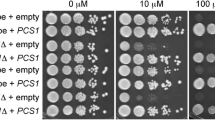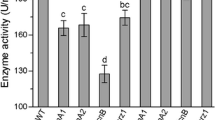Abstract.
The chitinase genes of Trichoderma spp. (ech42, chit33, nag1) contain one or more copies of a pentanucleotide element (5′-AGGGG-3′) in their 5′-noncoding regions. In Saccharomyces cerevisiae, this motif is recognized and bound by the stress response regulator proteins Msn2p/Msn4p. To test whether this motif in the chitinase promoters is bound by a Trichoderma Msn2/4p homolog, we have cloned a gene (seb1) from T. atroviride which encodes a C2H2 zinc-finger protein that is 62 (64)% identical to S. cerevisiae Msn2p (Msn4p) in the zinc-finger region, and almost identical to the G-box binding protein from Haematonectria haematococca and to polypeptides encoded by uncharacterized ORFs from Neurospora crassa and Aspergillus nidulans. Its zinc-finger domain specifically recognizes the AGGGG sequence of the ech42 and nag1 promoter in band-shift assays. However, a cDNA clone of seb1, when overexpressed in S. cerevisiae, was unable to complement a Δmsn2/4 mutant of S. cerevisiae. Levels of seb1 mRNA increased under conditions of osmotic stress (sorbitol, NaCl) but not under other stress conditions (cadmium sulfate, pH, membrane perturbance). A T. atroviride Δseb1 strain, produced by transformation with a seb1 copy disrupted by insertion of the A. nidulans amdS gene, showed strongly reduced growth on solid medium, but grew normally in liquid medium. In liquid medium, growth of the disruption strain was significantly more inhibited by the presence of 1 M sorbitol and 1 M NaCl than was that of the wild-type strain. Despite the presence of AGGGG elements in the promoter of the chitinase gene nag1, no differences in its expression were found between the parent and the disruption strain. EMSA analyses with cell-free extracts obtained from the seb1 disruption strain showed the presence of proteins that could bind to the AGGGG-element in nag1 and ech42. We therefore conclude that seb1 encodes a protein that is involved in the osmotic stress response, but not in chitinase gene expression, in T. atroviride.
Similar content being viewed by others
Author information
Authors and Affiliations
Additional information
Electronic Publication
Rights and permissions
About this article
Cite this article
Peterbauer, .C., Litscher, .D. & Kubicek, .C. The Trichoderma atroviride seb1 (stress response element binding) gene encodes an AGGGG-binding protein which is involved in the response to high osmolarity stress. Mol Gen Genomics 268, 223–231 (2002). https://doi.org/10.1007/s00438-002-0732-z
Received:
Accepted:
Issue Date:
DOI: https://doi.org/10.1007/s00438-002-0732-z




